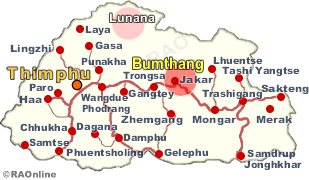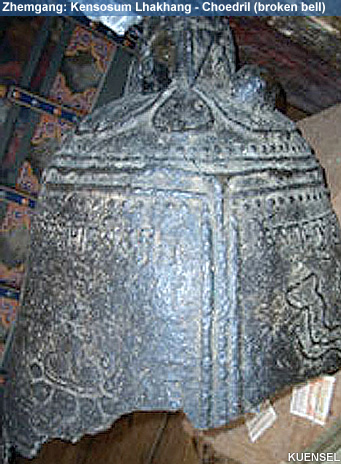|
Goenpas,
Monasteries & Lhakhangs
|
 |
Bhutan's
Religion Monasteries |
|
 |
Bhutan Information |
|
|
 |
|
Bumthang - Kenchosum lhakhang
|
 |
|
Rebuilding a 9th century temple
The rebuilding of one the country's oldest monasteries, the Kenchosum lhakhang in Bumthang, severely damaged by a fire in February 2010, which was held up from a lack of funds and government approval, is all set to begin. |
|
His Majesty the King and Her Majesty the Gyaltsuen attended the salang tendrel, a groundbreaking ceremony to seek permission and blessings from mother goddess of earth, to start the rebuilding.
A sachu bumter (a religious object to hold firmly and stabilise the soil) was placed at the site of the new lhakhang during the ground -breaking ceremony.
The more than 1,000-year old lhakhang, severely damaged by fire on the afternoon of February 24, 2010, after a butter lamp, which fell on the floor inside the monastery, caught fire on a window curtain.
The caretaker was at Tamzhing lhakhang, along with other monks, performing an annual five-day religious ceremony, when the incident took place.
Lopon Karma of Tamzhing dratshang, who will supervise the reconstruction, said a taxi driver and a monk risked their lives during the fire to save the lhakhang's main nangten - Due Sum Sangay, which are statues of the present, past and future Buddhas.He also said that most of the sacred relics were recovered intact.
 |
|
The reconstruction work on Kenchosum lhakhang, or the shrine of three jewels, could not take off as planned, due to lack of funds and delay in government approval, according to Sungtrul Rinpoche, who is looking after the lhakhang. 2Recently, we received approval from the home ministry and some funds," Sungtrul Rinpoche, who is head of the Drametse dratshang in Mongar and Tamzhing dratshang, located near Kenchosum monastery, said.
Lopon Karma said that they would not only reconstruct the lhakhang on the existing foundation and walls, but also construct a choekhang to perform religious ceremonies, and living quarters for the monks.
Estimated to cost about Nu 135M, the reconstruction is expected to take five years.
Kenchosum lhakhang is believed to have been built in the early ninth century by Thrisong Deutsen, after receiving instructions from Guru Rinpoche.At that time, it was a three-storied monastery.
|
|
The nye yig, or historical document the lhakhang has maintained, states that the Tibetan King Thrisong Deutsen sent Bami Thrizher from Yarlung as his representative to supervise the construction.
Legend has it that Guru Rinpoche himself is said to have designed and consecrated the Kenchosum lhakhang, which is also known as Tselung and Chokhor lhakhang.
Oral history also has it that name of Kenchosum lhakhang originated from three statues of Due Sum Sangay, which were believed to have flown from Kusumphel in Kurtoe.
Another sacred relic preserved in the monastery is the eighth century large broken bell (choedril).Lopon Karma said that the religious bell was believed to have been offered by a tsomem (mermaid) to Guru Rinpoche, when he performed the salang ceremony to build a three-storied lhakhang.
Although there is no written document to substantiate history, the oral tradition has it that, when the choedril was rung from Tamzhing, the sound could be heard as far as Lhasa in Tibet.Locals believed that the bell had become an eyesore for Tibetans, who then came to Bumthang and took away the bell but, unable to carry it across the mountains, they broke it.
Some time in the early part of the first millennium, Bonpo Dragtsal, whom some consider to be the first Bhutanese terton or treasure discoverer, is said to have extracted a dzogchen text from the lhakhang.
Dr Karma Phuntsho of Cambridge, in a write up, states that, in the 15th century, the temple became an important venue for the works of terton Pema Lingpa.
Following a prophecy to repair the temple, Pema Lingpa undertook the renovation of Chokhor lhakhang in 1479.He mobilised the people of Chokhor valley to work on the project, and invited an artist called Kungawo from Lhodrak, who restored the paintings.
To fund the project, Pema Lingpa was told in a prophecy to extract gold from behind the Buddha Vairocana statue.This he did in public, only to reveal a thumb-sized wax figure of a donkey, causing him much distress.
However, the next day he found two tiny pieces of gold hidden in the wax donkey, which miraculously turned out to be sufficient for gilding all statues and murals.The restoration took two years.
In a dramatic turn of events, Pema Lingpa, who was already a reputed religious figure, was once again called to the temple in 1490, this time by the people of Chokhor, who alleged that he unduly took out a turquoise from the back of the Vairocana statue.Pema Lingpa had to take a solemn oath before the statue that he did not.
| Contributed
byRinzin Wangchuk,, KUENSEL, Bhutan's National Newspaper, 2012 |
 |
top
| Information on Bhutan |
 |
|





